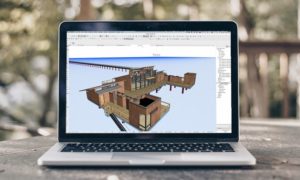In today’s rapidly evolving construction industry, BIM has become a necessary requirement for an increasing number of building projects. But what are the latest emerging digital trends? And which ones do you need to keep a keen eye on to stay ahead of the game? Don’t miss out on this opportunity to elevate your knowledge and stay competitive in the market.

BIM, Building Information Modeling, is transforming the construction industry.
From improved collaboration to increased efficiency, the benefits of BIM are undeniable. But what does the future hold in store? And what emerging trends
BIM and beyond: emerging trends and technologies
Emerging trends are happening on the daily, and it can be challenging to narrow it down to just a few. So, we have gathered 9 important BIM-related trends that have the potential to transform the way you work, market your brand, and get your products specified.
BIM trend 1: BIM mandates
Can manufacturers neglect to comply with BIM mandates in this day and age? The answer is no! BIM mandates are becoming a requirement rather than an option in the construction industry due to its benefits, such as improved project outcomes and increased efficiency.
This trend is not only driven by technological advancements but also by political strives to improve a nation’s competitiveness, productivity as well as social and environmental welfare. Manufacturers can gain a strategic advantage by complying with BIM mandates and creating BIM content to improve their product offering and better meet customer needs. To remain competitive in the market, it’s important for manufacturers to stay informed on the latest BIM requirements.
BIM trend 2: Adoption of BIM
Now you may be wondering, how does adoption impact manufacturers? Well, here’s the thing: BIM has become crucial as more private clients, companies and governmental entities recognize its value. According to USP’s Architectural Barometer Q2 2021 report, 44% of European Architects used BIM in 2021. That number’s expected to increase to 61% by 2025. “But what’s the fuel driving the massive increase in adoption? According to the 3,000 respondents in our February survey 2023 Architects, Engineers and Construction (AEC) on bimobject.com, the main motivators are to:
- Improve project quality: 28%
- Save time on the project: 22%
- Detect clashes, limit errors and omissions: 12%
- Gain a competitive advantage: 8%
- Increase profitability: 8%
- Win new business opportunities: 8%
- Adapt to regulation or law: 4%
- Respond to a request/call for tenders: 4%
- Other: 6%
Architects, interior designers and engineers are adapting their practices to incorporate BIM technology into their work. To accurately assess the environmental impact of their designs, these professionals rely on BIM objects provided by manufacturers as well as LCAs and EPDs. Therefore, the adoption of BIM is essential for manufacturers to remain competitive and meet the growing demand for BIM objects in construction projects.
BIM trend 3: Cloud-based technology
Cloud-based BIM offers many benefits, including increased collaboration, accessibility, and real-time updates. Its main benefit is information management in which BIM objects play a massive role. With this technology, stakeholders involved in building projects can access and update BIM models from anywhere in the world, making it easier to collaborate on projects and work together seamlessly.
Manufacturers can take advantage of this trend by ensuring that their products are available on cloud-based BIM platforms, making it easier for stakeholders to integrate their products into BIM models. Cloud-based BIM also offers real-time updates, which can help teams stay on top of project changes and progress. With on-premises software, stakeholders may need to wait for updates or work with outdated information, which can cause delays and mistakes.
BIM trend 4: The rise of digital twins
With the rise of digital twins, the construction industry is entering a new dimension of design and simulation. Digital twins are like doppelgängers of physical assets such as buildings or machinery, which allows stakeholders to see and analyze how their structures perform in different scenarios. By providing real-time data, digital twins enable better decision-making, optimize performance, and can even predict maintenance needs before they arise.
Digital twins have the ability to accurately simulate and predict the operational and behavioral aspects of a product based on real-world conditions. This enables manufacturers to make informed decisions about maintenance and support needs, optimizing product performance.

BIM-Possible Future
The future of BIM is full of possibilities. Manufacturers have a wealth of new tools and technologies at their disposal. But to take advantage of these opportunities, manufacturers must be willing to invest in the necessary training and tools, and stay up-to-date with the latest developments in the field.
BIM objects are becoming increasingly common in the construction industry, and it’s essential for manufacturers to prepare for these changes by ensuring that their products are BIM-compatible. By embracing these technologies, manufacturers can unlock new opportunities for growth, efficiency, and innovation. It’s time to start exploring the possibilities of BIM. The future is exciting, and the possibilities are endless.




Leave A Comment